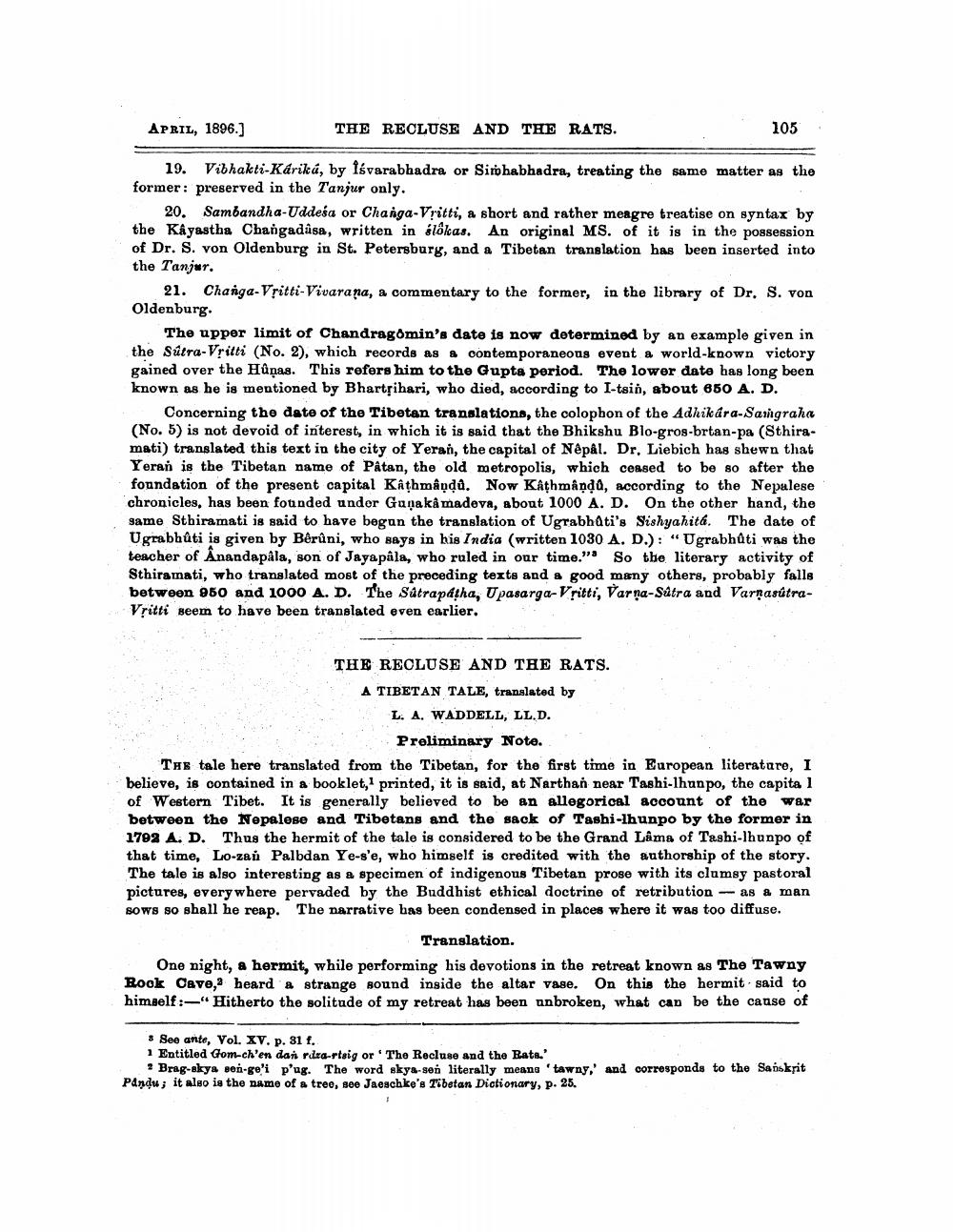________________
APRIL, 1896.)
THE RECLUSE AND THE RATS.
105
19. Vibhakti-Kariká, by Isvarabhadra or Sirohabhadra, treating the same matter as the former: preserved in the Tanjur only.
20. Sambandha-Uddeśa or Changa-Vritti, a short and rather meagre treatise on syntax by the Kayastha Changadása, written in klókas. An original MS. of it is in the possession of Dr. S. von Oldenburg in St. Petersburg, and a Tibetan translation has been inserted into the Tanjur.
21. Changa-Vritti-Vivarana, a commentary to the former, in the library of Dr. S. von Oldenburg
The upper limit of Chandragomin's date is now determined by an example given in the Sútra-Vritti (No. 2), which records as a contemporaneous event a world-known victory gained over the Hûņas. This refers him to the Gupta period. The lower date has long been known as he is mentioned by Bhartrihari, who died, according to I-tsin, about 650 A. D.
Concerning the date of the Tibetan translations, the colopbon of the Adhikára-Sangraha (No. 5) is not devoid of interest, in which it is said that the Bhikshu Blo-gros-brtan-pa (Sthiramati) translated this text in the city of Yeran, the capital of Népål. Dr. Liebich has shewn that Yeran is the Tibetan name of Patan, the old metropolis, which ceased to be so after the foundation of the present capital Kathmandu. Now Kathmandu, according to the Nepalese chronicles, has been founded under Gunakâ madeva, about 1000 A. D. On the other hand, the same Sthiramati is said to have began the translation of Ugrabhati's Sishyahita. The date of Ugrabhùti is given by Bórúni, who says in his India (written 1030 A. D.): "Ugrabhậti was the teacher of Anandapála, son of Jaya pala, who ruled in our time." So the literary activity of Sthiramati, who translated most of the preceding texts and a good many others, probably falls between 050 and 1000 A. D. The Sútrapátha, Upasarga-Vritti, Varna-Satra and VarnasútraVritti seem to have been translated even earlier,
THE RECLUSE AND THE RATS. A TIBETAN TALE, translated by
L. A. WADDELL, LL.D.
Preliminary Note. The tale here translated from the Tibetan, for the first time in European literature, I believe, is contained in a booklet, printed, it is said, at Narthan near Tashi-lhunpo, the capita 1 of Western Tibet. It is generally believed to be an allegorical account of the war between the Nepalese and Tibetans and the sack of Tashi-lhunpo by the former in 1792 A. D. Thus the hermit of the tale is considered to be the Grand Lâms of Tashi-lhunpo of that time, Lo-zan Palbdan Ye-s'e, who himself is credited with the authorship of the story. The tale is also interesting as a specimen of indigenous Tibetan prose with its clumsy pastoral pictures, everywhere pervaded by the Buddhist ethical doctrine of retribution - as a man SOWS so shall he reap. The narrative has been condensed in places where it was too diffuse.
Translation. One night, a hermit, while performing his devotions in the retreat known as The Tawny Rook Cave, heard a strange sound inside the altar vase. On this the hermit said to himself:-"Hitherto the solitude of my retreat has been anbroken, what can be the cause of
8 See ante, Vol. XV. p. 31 f. 1 Entitled Gom-ch'en dan rixa-rtsig or 'The Recluse and the Rate.
2 Brag-skys sen-ge'i p'ug. The word skya-sen literally means 'tawny,' and corresponds to the Sanskrit Pandu; it also is the name of a tree, see Jaeschke's Tibetan Dictionary, p. 25.




